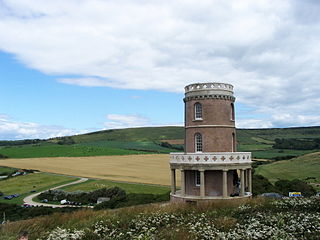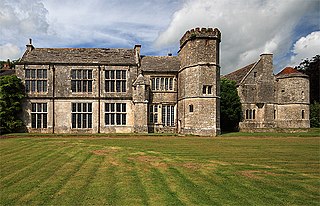
Terminal Tower is a 52-story, 235 m (771 ft), landmark skyscraper located on Public Square in downtown Cleveland, Ohio, United States. Built during the skyscraper boom of the 1920s and 1930s, it was the second-tallest building in the world when it was completed. Terminal Tower stood as the tallest building in North America outside of New York City from its completion in 1927 until 1964. It was the tallest building in the state of Ohio until the completion of Key Tower in 1991, and remains the second-tallest building in the state. The building is part of the Tower City Center mixed-use development, and its major tenants include Forest City Enterprises, which maintained its corporate headquarters there until 2018, and Riverside Company.

Sandringham House is a country house in the parish of Sandringham, Norfolk, England. It is one of the royal residences of Charles III, whose grandfather, George VI, and great-grandfather, George V, both died there. The house stands in a 20,000-acre (8,100 ha) estate in the Norfolk Coast Area of Outstanding Natural Beauty. The house is listed as Grade II* and the landscaped gardens, park and woodlands are on the National Register of Historic Parks and Gardens.
The Landmark Trust is a British building conservation charity, founded in 1965 by Sir John and Lady Smith, that rescues buildings of historic interest or architectural merit and then makes them available for holiday rental. The Trust's headquarters is at Shottesbrooke in Berkshire.

Kingswear Castle is an artillery fort, built to protect Dartmouth harbour in Devon, England. It was constructed between 1491 and 1502 in response to the threat of French attack and was one of the first purpose-built artillery forts in Britain. By the end of the 16th century, however, improvements in the range of artillery weapons had reduced the utility of the castle. It took part in the English Civil War and continued to be armed until the early 18th century, but fell into ruin. Restored as a summer house in 1855, in the 21st century it is managed by the Landmark Trust as a holiday let.
Wood Farm is a farmhouse on the British Royal Family's Sandringham Estate in Norfolk, England. Historically occupied by members of the Royal Family and their guests, the house was a long favourite of Elizabeth II. From his retirement in 2017, the house was home to Prince Philip, Duke of Edinburgh.
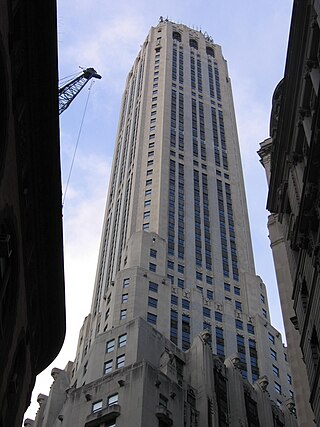
20 Exchange Place, formerly the City Bank–Farmers Trust Building, is a skyscraper in the Financial District of Lower Manhattan in New York City. Completed in 1931, it was designed by Cross & Cross in the Art Deco style as the headquarters of the City Bank–Farmers Trust Company, predecessor of Citigroup. The building, standing at approximately 741 feet (226 m) with 57 usable stories, was one of the city's tallest buildings and the world's tallest stone-clad building at the time of its completion. While 20 Exchange Place was intended to be the world's tallest building at the time of its construction, the Great Depression resulted in the current scaled-back plan.

Freston Tower is a six-storey red brick folly south of Ipswich, Suffolk in the village of Freston. It stands on the banks of the River Orwell.
The Radwell Manor Railway was a 10+1⁄4 in gauge miniature railway situated in the village of Radwell, near Felmersham, in North Bedfordshire, England. It was built by Mr. H. W. Franklin, who was closely associated with the Bassett-Lowke company of Northampton, and whose products were often tested on its 0.75 mi (1.2 km) of track. The privately run railway opened in 1920, and ceased operating with the onset of the Second World War, around 1939. However, much of the railway remained intact until at least the early 1960s because it was seen in approximately 1960-1962 by a young railway enthusiast who was exploring the area.

Great Bircham Windmill is a Grade II listed tower mill in Great Bircham, Norfolk, England.
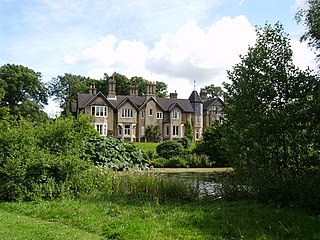
York Cottage is a house in the grounds of Sandringham House in Norfolk, England.

The Water Tower is a building in Kenilworth, Warwickshire, England. It is understood that the building was constructed as a windmill in the mid 18th Century by Joseph Lee of Warwick, described as Gentlemen and John Lamb of Warwick, Haberdasher. There is evidence of a sale in 1778 of the Mill as a going concern. The building continued to be used as a working windmill until 1854 when steam power was introduced. In 1885 the mill machinery was removed and the building converted into a water tower. This involved the doubling of the height of the brickwork and surmounting it with a 26,000-gallon iron tank. This became the town's first Waterworks and provided most of Kenilworth's water supply until 1939. The supply from this tank was in fact in use for auxiliary purposes until approximately 1964. In 1970 Kenilworth Urban District Council, anxious to ensure the preservation of such an important and historic landmark, offered it for sale by tender on condition that it should be sympathetically restored and converted for use as a private dwelling house. Plans submitted by the Architect, Mr Edward Byron of Leamington Spa, on behalf of Lt Col Michael Wheat, were accepted and a conversion was commenced in late 1972 and completed in 1974. This imaginative conversion incorporates a new ground floor extension cleverly designed to harmonise with the character. The tower and the whole now forms a unique and comfortable home successfully linking the past with the present.

Chatley Heath is part of 336 hectare reserve including Wisley Common, Ockham and parts of Hatchford. It is an area with a mixed habitats including heathland, ancient woodland and conifer woodland. On the top of Chatley heath is a tower built as part of the Royal Navy Semaphore line.

The Nandu River is the longest river in Hainan Province, China. Its tributary is the Xinwu River. The river discharges into the Nandu River estuary at Haikou city, and then into Qiongzhou Strait.

The Ancient House is a medieval timber-framed and partly pargeted building located in Clare in Suffolk, England. It is a Grade I listed building.
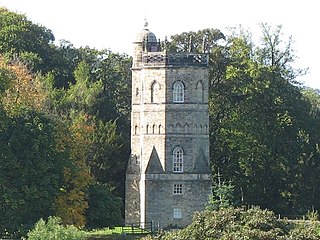
The Culloden Tower was built as a parkland ornament or folly in about 1746 on the estate of John Yorke MP, at Richmond, North Yorkshire. It was built on the site of an earlier pele tower, the remains of which possibly form the rectangular base. It is also known as The Temple or The Cumberland Temple, in celebration of the victorious Duke of Cumberland's army over the forces of the pretender Prince Charles Edward Stuart at the battle of Culloden in 1746.
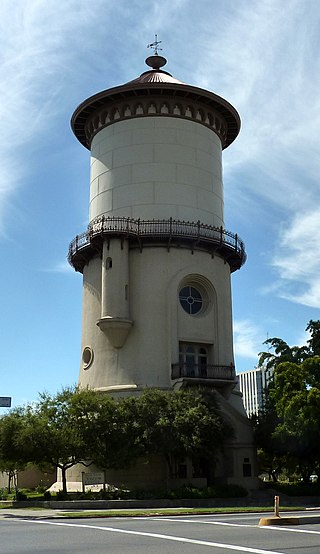
The Old Fresno Water Tower is a historic water tower in Fresno, California. It is listed on the National Register of Historic Places. Designed by George Washington Maher, the tower was completed in late 1894. It ceased operation in 1963 and has served as a visitors' center since 2001.

Clomantagh Castle is a 15th-century tower house located near Freshford, County Kilkenny, in Ireland. Originally constructed in the 1430s, additional buildings and outbuildings were added in the subsequent centuries - including a connected 19th century farmhouse. Carvings on the castle's walls include a Sheela na gig relief.






